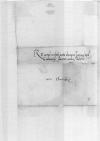Reverendo in Christo Patri, domino ⌊Ioanni episcopo Culmensi⌋ sincere nobis dilecto
⌊Sigismundus⌋ Dei gratia rex ⌊Poloniae⌋, magnus dux ⌊Lituaniae⌋, ⌊Russiae⌋, ⌊Prussiae⌋ ac ⌊Masoviae⌋ etc. dominus et heres
Reverende in Christo Pater, sincere nobis dilecte.
Accepimus e litteris Strenuitatis Tuae causas, quam ob rem Strenuitas Tua se a munere legationis ad instantia ⌊comitia regni⌋ obeundae eximi a nobis velit. Sed eae causae, qualescumque sunt, apud nos tamen tantum loci habere non possunt, ut postulata Strenuitatis Tuae faciamus. Cum enim Strenuitas Tua communi ordinum Prussiae consensu ad hoc munus delecta sit, nobis neutiquam integrum est illorum voluntati et iudicio adversari. Satis faciet ergo Strenuitas Tua suorum desiderio et ad ⌊comitia⌋ cum reliquis collegis suis tempori veniet, factura in eo officium suum.
Quae bene valeat.
⌊Sandomiriae⌋, VII Novembris anno Domini MDXXXVI, regni nostri anno XXX.
Ad mandatum sacrae regiae maiestatis proprium

